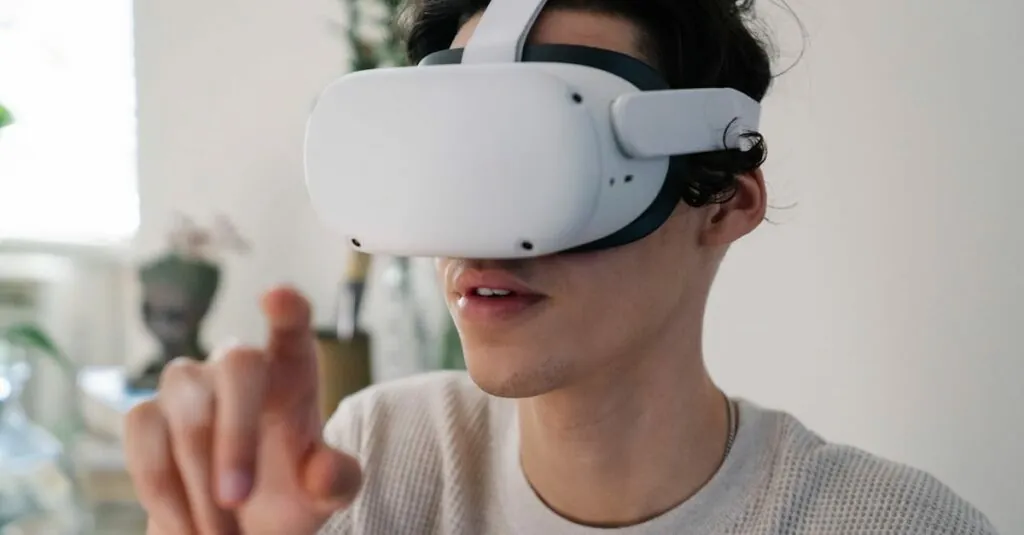Table of Contents
ToggleImagine cruising down the road with a co-pilot that never gets tired or distracted. Augmented reality in the automotive world is turning this dream into a reality, transforming how drivers interact with their vehicles and the environment. From heads-up displays that project navigation right onto the windshield to smart glasses that guide you through complex repairs, AR is revving up the driving experience like never before.
As technology zooms ahead, automotive manufacturers are racing to harness the power of augmented reality. It’s not just a flashy gimmick; it’s a game-changer that enhances safety, boosts efficiency, and makes driving a whole lot more fun. Buckle up as we explore how this futuristic tech is reshaping the roads we travel and the cars we drive. Who knew the future of driving could be so entertaining?
Overview of Augmented Reality for Automotive
Augmented reality (AR) significantly revolutionizes the automotive sector by integrating digital information with the real world. Technology enhances navigation through heads-up displays, offering drivers real-time directions directly on the windshield. Features like lane departure warnings and speed alerts improve safety by maintaining driver attention on the road.
Interactive dashboards are another key aspect of AR, displaying relevant data without distracting drivers. Manufacturers utilize AR to streamline maintenance and repair tasks. Smart glasses help technicians visualize engine configurations and wiring layouts, reducing error rates and increasing efficiency.
Additionally, AR aids in the purchasing process. Customers can explore vehicle features virtually, previewing customizations before making decisions. This immersive experience encourages informed choices and increases customer satisfaction.
Training programs for automotive professionals benefit from augmented reality as well. Simulations replicate driving scenarios, equipping learners with hands-on experience in a controlled environment. As a result, they gain confidence and skills without risking safety.
In the area of vehicle design, AR facilitates collaboration among engineers and stakeholders. Designers visualize concepts in 3D, enabling immediate feedback and adjustments. This iterative process shortens development cycles and enhances creativity.
AR doesn’t just stop at enhancing personal vehicles; it integrates into public transportation systems too. Urban planners employ augmented reality to visualize infrastructure changes and assess traffic patterns efficiently.
Overall, augmented reality represents a significant leap in automotive technology. Innovations enhance safety, increase operational efficiency, and improve the consumer experience across various touchpoints in the industry.
Benefits of Augmented Reality in Automotive
Augmented reality (AR) significantly enhances various dimensions within the automotive industry, improving both user interactions and driving safety.
Enhanced User Experience
AR transforms the user experience by integrating digital overlays with real-world visuals. Heads-up displays present navigation instructions directly on the windshield, allowing drivers to focus on the road. Smart glasses assist technicians by providing real-time repair information, minimizing downtime. With AR, customers can virtually explore vehicles before purchasing, making the selection process more engaging. Customization options appear as visual aids, enabling potential buyers to see features in their desired models. This advanced interaction fosters a more informed decision-making process, leading to higher satisfaction rates.
Improved Safety Features
Safety advancements stemming from AR applications significantly enhance driving experiences. Real-time information, such as lane departure warnings and speed alerts, are crucial for maintaining safe driving practices. AR systems display relevant data without causing distractions, which enhances driver focus on the road. Enhanced navigation by visual markers directs drivers around obstacles and ensures efficient route planning. Additionally, AR can facilitate emergency response measures by projecting safe escape routes during critical situations. As a result, the fusion of augmented reality and safety protocols creates a more secure environment for drivers and passengers alike.
Applications of Augmented Reality in Automotive
Augmented reality (AR) significantly enhances various aspects of the automotive industry. The following areas illustrate its impactful applications.
Navigation and Wayfinding
Navigation represents one of the most practical uses of AR in vehicles. With heads-up displays, AR projects critical navigation information directly onto the windshield. Drivers receive real-time directions, minimizing distractions and maintaining focus on the road. Lane departure warnings and speed alerts appear as digital overlays, ensuring heightened awareness of surroundings. For instance, AR can highlight the correct lane for a turn, reducing the chance of errors during navigation. This integration significantly improves the overall driving experience, making journeys safer and more efficient.
Maintenance and Repairs
Maintenance tasks benefit greatly from AR technology, providing technicians with enhanced tools. Smart glasses enable mechanics to access real-time repair information during vehicle service. Visual aids guide technicians step-by-step through complex repairs, streamlining the process. This real-time data integration reduces downtime and improves accuracy. For example, AR can overlay repair instructions directly onto the component being serviced, ensuring technicians follow the correct procedures. As a result, the combination of AR and maintenance increases efficiency and enhances vehicle reliability.
Challenges and Limitations
Integrating augmented reality into the automotive industry presents several challenges and limitations. Hardware limitations often hinder performance, as existing devices may not operate efficiently with AR applications. High costs related to AR technology development also significantly impact its adoption in mass-market vehicles. Cars equipped with AR features generally involve increased expenses for both manufacturers and consumers.
User experience issues arise due to potential distractions caused by AR displays. Excessive information on the screen can overwhelm drivers, leading to misinterpretations. Additionally, inconsistent data accuracy may create doubts in AR navigation systems, reducing driver confidence. Concerns about data integration from various sources also complicate the seamless operation of AR systems.
Installation of AR systems can pose logistical challenges. Retrofitting existing vehicles requires additional resources and time, often preventing quick implementation. Training for technicians and end-users constitutes another barrier, as manufacturers must ensure stakeholders fully understand and can effectively use the technology.
Regulatory hurdles remain significant in the automotive sector. Compliance with safety standards and government regulations limits the implementation of new technologies. These restrictions can slow the pace at which AR features are introduced into vehicles, delaying potential benefits for consumers.
Privacy concerns surface with the increasing reliance on data collection. Users may hesitate to engage with AR systems that require sensitive information. Addressing these challenges is crucial for the successful integration of augmented reality in the automotive industry.
Future Trends in Augmented Reality for Automotive
Augmented reality is set to drive significant advancements in automotive technology. The evolution of heads-up displays allows for richer, interactive navigation experiences, enhancing situational awareness for drivers. Smart glasses development continues to improve, providing technicians with crucial repair information in real time, thus streamlining complex tasks.
Vehicle design processes are becoming increasingly efficient through AR tools. Engineers visualize 3D models while working collaboratively, leading to faster development cycles. Consumer experiences benefit from AR applications that showcase vehicle customizations, allowing potential buyers to interact with models before purchasing.
In addition, safety features in AR are advancing. Systems are integrating with advanced driver-assistance technologies, offering features such as adaptive displays that change based on conditions and alerts for potential obstacles. Incorporating AI in AR systems enhances data accuracy, providing clearer navigation guidance and improving overall road safety.
Public transportation applications also show promise. AR helps urban planners visualize changes in infrastructure and assess traffic patterns more effectively. Such tools facilitate smarter city planning, leading to better public transit solutions.
The barriers to AR integration remain a significant concern. Addressing issues like hardware limitations and high development costs is essential for widespread adoption. Concerns about user distractions and data accuracy must also be prioritized to ensure effective implementation.
Overall, the ongoing development of augmented reality in the automotive sector signals a transformative shift. As challenges are met with innovative solutions, the future holds exciting possibilities for drivers, technicians, and consumers alike.
Augmented reality is reshaping the automotive landscape by enhancing safety and user experience. Its integration into navigation systems and maintenance processes streamlines operations and empowers drivers and technicians alike. As AR technology continues to evolve, it promises to make vehicle design more efficient and purchasing experiences more engaging.
Despite facing challenges like hardware limitations and user distractions, the potential benefits of AR in automotive applications are undeniable. The future of driving and vehicle interaction looks promising as innovative solutions address these obstacles. Embracing augmented reality could lead to a safer and more enjoyable journey for everyone involved in the automotive ecosystem.




